Sequenced plant genomes
This site attempts to track all plant genomes with published sequences, and at least some of the genomes currently in the process of being sequenced. Genomes are divided into four states:
- Published: A complete genome sequence is available, and anyone can publish papers on it without restriction.
- Unpublished: The complete sequence (or a substantially complete sequence) is available, but whole genome analysis cannot be published until the group that sequenced the genome publishes their own paper describing it. These restrictions are outlines by the Fort Lauderdale Convention.
- Incomplete: A partial assembly is available, but sequencing and/or assembly and/or gene annotation is ongoing.
- Unreleased: Genome sequencing has at least begun, but no data has been made publicly available.
Phylogenetic Tree

Eudicots
The eudicots are the largest group of flowering plants on the planet.
Asterids
The asterids are a group of plants within the eudicots that include species like the solanacious vegetables (Tobacco, Tomato, Potato, Peppers and Eggplant) and the sunflowers. There are not currently any published plant genomes from species in the Asterid clade, but there are at least three genome projects with some level of sequence publicly available.
Tomato (incomplete)
The tomato (Solanum lycopersicum) genome project is not yet complete. The version of the genome currently loaded into CoGe is assembled into pseudomolecules[1] but does not contain [2]. The most recent assembly is 1.03 which is assembled from 22x coverage sequencing using 454 technology. Read more about the tomato genome project here or see it in GenomeView here.
Potato (incomplete)
The potato genome project is not yet complete. Read more about the potato genome projector see it in GenomeView here.
Monkey Flower (incomplete)
The monkey flower (Mimulus guttatus) genome is not yet complete. The version of the genome currently loaded into CoGe is not assembled into pseudomolecules[1] but does contain genome models[2] Read more about the monkey flower genome on phytozomeor see the current assembly in GenomeView here.
Rosids
Grape
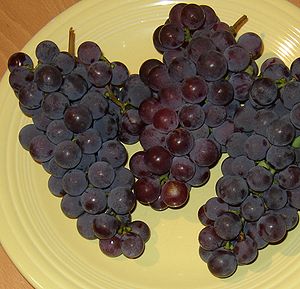
The genome sequence of the wine grape (Vitis vinifera) was published by a group of French and Italian researchers in 2007. The variety of grape sequenced was the Pinot Noir.
Grape diverged early from the two main groups of species in the rosids (eurosids I and eurosids II) and has not experienced any whole genome duplications since that divergence making it an important outgroup for comparisons to other rosid species as well as providing a great resource for studying the ancient hexaploidy that preceeding the radiation of rosid species (and possibly the radiation of eudicot species).
The version of the grape genome in CoGe contains ~500 megabases of sequence and X annotated genes spread across 19 chromosomes.
The genome paper:
Jaillon, O., Aury, J., Noel, B., Policriti, A., Clepet, C., Casagrande, A., Choisne, N., Aubourg, S., Vitulo, N., Jubin, C., Vezzi, A., Legeai, F., Hugueney, P., Dasilva, C., Horner, D., Mica, E., Jublot, D., Poulain, J., Bruyère, C., Billault, A., Segurens, B., Gouyvenoux, M., Ugarte, E., Cattonaro, F., Anthouard, V., Vico, V., Del Fabbro, C., Alaux, M., Di Gaspero, G., Dumas, V., Felice, N., Paillard, S., Juman, I., Moroldo, M., Scalabrin, S., Canaguier, A., Le Clainche, I., Malacrida, G., Durand, E., Pesole, G., Laucou, V., Chatelet, P., Merdinoglu, D., Delledonne, M., Pezzotti, M., Lecharny, A., Scarpelli, C., Artiguenave, F., Pè, M., Valle, G., Morgante, M., Caboche, M., Adam-Blondon, A., Weissenbach, J., Quétier, F., & Wincker, P. (2007). The grapevine genome sequence suggests ancestral hexaploidization in major angiosperm phyla Nature, 449 (7161), 463-467 DOI: 10.1038/nature06148
Eurosids 1
Cucumber
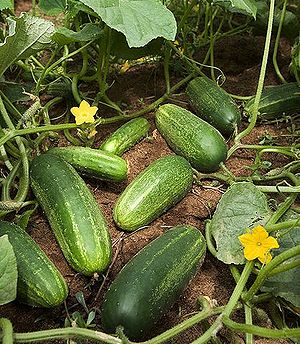
The genome sequence of cucumber (Cucumis sativus) was published in late 2009. The genome of the inbred line "'Chinese long' 9930" was sequenced using a combination of Illumina short read sequencing (68.3x coverage) and Sanger sequencing (3.9x coverage). The complete published genome consists of 243.5 megabases of sequence and 26,682 protein coding genes, 72.8% of which can been anchered to the seven cucumber chromosomes, with the rest unanchored.
The publication also included a genetic map with a total length of 581 cM based on 1,885 markers. Resources from this version of the cucumber genome are available at this site.
Independently a group of researchers in the US have released a draft of a cucumber genome sequence of the inbred line Gy14. This version of the genome was assembled from 454 sequencing reads and the current release consists of 203 megabases of sequence and a predicted 21491 protein coding genes spread over 4219 scaffolds. This version is available at Phytozome.
The genome paper: Huang, S., Li, R., Zhang, Z., Li, L., Gu, X., Fan, W., Lucas, W., Wang, X., Xie, B., Ni, P., Ren, Y., Zhu, H., Li, J., Lin, K., Jin, W., Fei, Z., Li, G., Staub, J., Kilian, A., van der Vossen, E., Wu, Y., Guo, J., He, J., Jia, Z., Ren, Y., Tian, G., Lu, Y., Ruan, J., Qian, W., Wang, M., Huang, Q., Li, B., Xuan, Z., Cao, J., Asan, ., Wu, Z., Zhang, J., Cai, Q., Bai, Y., Zhao, B., Han, Y., Li, Y., Li, X., Wang, S., Shi, Q., Liu, S., Cho, W., Kim, J., Xu, Y., Heller-Uszynska, K., Miao, H., Cheng, Z., Zhang, S., Wu, J., Yang, Y., Kang, H., Li, M., Liang, H., Ren, X., Shi, Z., Wen, M., Jian, M., Yang, H., Zhang, G., Yang, Z., Chen, R., Liu, S., Li, J., Ma, L., Liu, H., Zhou, Y., Zhao, J., Fang, X., Li, G., Fang, L., Li, Y., Liu, D., Zheng, H., Zhang, Y., Qin, N., Li, Z., Yang, G., Yang, S., Bolund, L., Kristiansen, K., Zheng, H., Li, S., Zhang, X., Yang, H., Wang, J., Sun, R., Zhang, B., Jiang, S., Wang, J., Du, Y., & Li, S. (2009). The genome of the cucumber, Cucumis sativus L. Nature Genetics, 41(12), 1275-1281 DOI: 10.1038/ng.475
Poplar

The genome sequence of the black cottonwood tree (Populus trichocarpa) was published in 2006. The genome was originally sequenced to a coverage of 7.5x using Sanger sequencing. Poplar was the third plant genome to be published, and is now one of two published genomes of tree species (the other being papaya). Poplar contains a whole genome duplication that is not shared by any other plant species with a sequenced genome. The most recent version of the poplar genome in CoGe is v2 available on Phytozome which includes ~370 megabases of sequence and 41377 protein coding genes spread over 19 chromosomes.
The genome paper: Tuskan, G., DiFazio, S., Jansson, S., Bohlmann, J., Grigoriev, I., Hellsten, U., Putnam, N., Ralph, S., Rombauts, S., Salamov, A., Schein, J., Sterck, L., Aerts, A., Bhalerao, R., Bhalerao, R., Blaudez, D., Boerjan, W., Brun, A., Brunner, A., Busov, V., Campbell, M., Carlson, J., Chalot, M., Chapman, J., Chen, G., Cooper, D., Coutinho, P., Couturier, J., Covert, S., Cronk, Q., Cunningham, R., Davis, J., Degroeve, S., Dejardin, A., dePamphilis, C., Detter, J., Dirks, B., Dubchak, I., Duplessis, S., Ehlting, J., Ellis, B., Gendler, K., Goodstein, D., Gribskov, M., Grimwood, J., Groover, A., Gunter, L., Hamberger, B., Heinze, B., Helariutta, Y., Henrissat, B., Holligan, D., Holt, R., Huang, W., Islam-Faridi, N., Jones, S., Jones-Rhoades, M., Jorgensen, R., Joshi, C., Kangasjarvi, J., Karlsson, J., Kelleher, C., Kirkpatrick, R., Kirst, M., Kohler, A., Kalluri, U., Larimer, F., Leebens-Mack, J., Leple, J., Locascio, P., Lou, Y., Lucas, S., Martin, F., Montanini, B., Napoli, C., Nelson, D., Nelson, C., Nieminen, K., Nilsson, O., Pereda, V., Peter, G., Philippe, R., Pilate, G., Poliakov, A., Razumovskaya, J., Richardson, P., Rinaldi, C., Ritland, K., Rouze, P., Ryaboy, D., Schmutz, J., Schrader, J., Segerman, B., Shin, H., Siddiqui, A., Sterky, F., Terry, A., Tsai, C., Uberbacher, E., Unneberg, P., Vahala, J., Wall, K., Wessler, S., Yang, G., Yin, T., Douglas, C., Marra, M., Sandberg, G., Van de Peer, Y., & Rokhsar, D. (2006). The Genome of Black Cottonwood, Populus trichocarpa (Torr. & Gray) Science, 313 (5793), 1596-1604 DOI: 10.1126/science.1128691
Cassava (incomplete)
Cassava (Manuhot esculenta) is the most important crop that most people in America and Europe have never heard of (except perhaps in the form of tapioca). Originally domesticated in South America, cassava is now an important food source in Southeast Asia and Africa. The current draft genome is made available through phytozome and consists of 416 megabases of sequence spread over 11,243 contigs. This is only a little over 50% of the estimated total size of the cassava genome, but the people involved in the sequencing and assembly believe it represents the majority of the non-repetitive genome. The current release also includes 47,164 predicted genes.
Legumes
Legumes (the plant family Fabaceae) contained within the eurosid II clade. The family is perhaps best known for the fact that many of the species it contains form symbiotic relationships with nitrogen fixing bacteria. The bacteria are sheltered and feed within special nodules in the roots of these plants and in return the plant benefits from the bacteria's ability to convert the nitrogen in our atmosphere into bio-available forms (bioavailable nitrogen is often a limiting nutrient for other plant species).
Medicago (unpublished)
Medicago (Medicago truncatula) is small legume used as a model species for nodule formation and nitrogen fixing. The latest release of the medicago genome is Mt3.0 which includes 240 megabases of sequence associated with Medicago's eight chromosomes, plus 16.6 megabases of unanchored sequence. Read more at International Medicago Genome Annotation Group's webpage.
Soybean
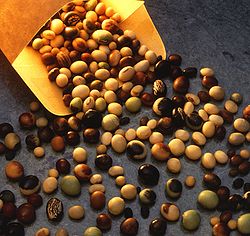
Soybeans (Glycine max) are an important crop species valued both as a source of protein and for their ability to fix nitrogen, which reduces the amount of fertilizer that needs to be applied to whatever crop is grown in the same field the following year.
The soybean genome was published in early 2010 and contained 950 megabases of sequence as well as a predicted 46,430 protein coding genes distributed over twenty chromosomes. The ancestors of soybean went through two whole genome duplications since the ancient hexaploidy as the base of the eudicot lineage with the older estimated to have occured 59 million years ago and the more recent estimated to have occured 13 million years ago.
The Genome Paper: Schmutz, J., Cannon, S., Schlueter, J., Ma, J., Mitros, T., Nelson, W., Hyten, D., Song, Q., Thelen, J., Cheng, J., Xu, D., Hellsten, U., May, G., Yu, Y., Sakurai, T., Umezawa, T., Bhattacharyya, M., Sandhu, D., Valliyodan, B., Lindquist, E., Peto, M., Grant, D., Shu, S., Goodstein, D., Barry, K., Futrell-Griggs, M., Abernathy, B., Du, J., Tian, Z., Zhu, L., Gill, N., Joshi, T., Libault, M., Sethuraman, A., Zhang, X., Shinozaki, K., Nguyen, H., Wing, R., Cregan, P., Specht, J., Grimwood, J., Rokhsar, D., Stacey, G., Shoemaker, R., & Jackson, S. (2010). Genome sequence of the palaeopolyploid soybean Nature, 463 (7278), 178-183 DOI: 10.1038/nature08670
Eurosids 2
Papaya
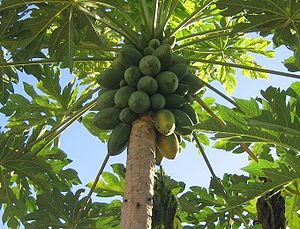
The genome of the papaya tree (Carica papaya) was published in the early 2008. Papaya was one of the earliest crops to be genetically modified (in papaya's case to resist the devastating papaya ringspot virus) and the sequenced genome actually comes from one of the genetically modified varieties (SunUp). The papaya genome was sequenced to a coverage of 3x using Sanger sequencing. Papaya has not experienced further [whole genome duplications] since the ancient hexaploidy shared by all currently sequenced eudicots. As the most closely related species to Arabidopsis with a currently sequenced genome that has not experienced the two subsequence whole genome duplications found in the Arabidopsis lineage, papaya is a useful outgroup, although the ancestors of Arabidopsis and Papaya split ~72 million years ago.
The papaya genome is estimated to be have a size of 372 megabases, spread across nine chromosomes, and contain (X) genes. The version of papaya within CoGe is organized into super contigs, but does contain a number of gaps.
The genome paper:
Ming, R., Hou, S., Feng, Y., Yu, Q., Dionne-Laporte, A., Saw, J., Senin, P., Wang, W., Ly, B., Lewis, K., Salzberg, S., Feng, L., Jones, M., Skelton, R., Murray, J., Chen, C., Qian, W., Shen, J., Du, P., Eustice, M., Tong, E., Tang, H., Lyons, E., Paull, R., Michael, T., Wall, K., Rice, D., Albert, H., Wang, M., Zhu, Y., Schatz, M., Nagarajan, N., Acob, R., Guan, P., Blas, A., Wai, C., Ackerman, C., Ren, Y., Liu, C., Wang, J., Wang, J., Na, J., Shakirov, E., Haas, B., Thimmapuram, J., Nelson, D., Wang, X., Bowers, J., Gschwend, A., Delcher, A., Singh, R., Suzuki, J., Tripathi, S., Neupane, K., Wei, H., Irikura, B., Paidi, M., Jiang, N., Zhang, W., Presting, G., Windsor, A., Navajas-Pérez, R., Torres, M., Feltus, F., Porter, B., Li, Y., Burroughs, A., Luo, M., Liu, L., Christopher, D., Mount, S., Moore, P., Sugimura, T., Jiang, J., Schuler, M., Friedman, V., Mitchell-Olds, T., Shippen, D., dePamphilis, C., Palmer, J., Freeling, M., Paterson, A., Gonsalves, D., Wang, L., & Alam, M. (2008). The draft genome of the transgenic tropical fruit tree papaya (Carica papaya Linnaeus) Nature, 452 (7190), 991-996 DOI: 10.1038/nature06856
Arabidopsis
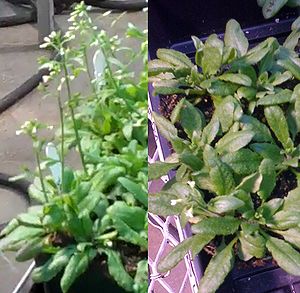
Arabidopsis thaliana is a poplar model plant species, partially as a result of its short generation time and compact size. The genome of Arabidopsis was also the first plant genome to be published back in 2000. The current release of the Arabidopsis genome is TAIR9:
The TAIR9 release contains 27,379 protein coding genes, 4827 pseudogenes or transposable elements and 1312 ncRNAs (33,518 genes in all, 39,640 gene models).
The Arabidopsis genome is ~120 megabases of sequence spread across five chromosomes.
Genome resources:
Arabidopsis lyrata genome:
Arabidopsis lyrata also has a sequenced, though unpublished, genome. As a close relative of A. thaliana, the lyrata genome is valuable for comparative genomics. A. lyrata also is self-incompatable, while A. thaliana reproduced primarily through self-fertilization. The lyrata genome is available within CoGe.
The 1001 genomes project[3] plans to sequence the genomes of 1001 different varieties of Arabidopsis. Currently 88 are available with more in progress.
The Genome Paper: The Arabidopsis Genome Initiative (2000). Analysis of the genome sequence of the flowering plant Arabidopsis thaliana. Nature, 408 (6814), 796-815 DOI: 10.1038/35048692
Monocots
Banana (unreleased)
Baring a contender coming out of left field, the banana genome is on track to be the first non-grass published non-grass monocot genome. It will be incredibly valuable from a comparative genomics standpoint for studying the evolution of grass genomes. However banana isn't being sequenced to make the lives of comparative genomicists easier, but because of the key role many banana species play in the tropical food production. Bananas are also a target of genetic engineering, since the fact that most cultivated breeds are triploid and unable to reproduce sexually (the reason bananas aren't full of seeds) makes conventional breeding impossible, and bananas suffer from a number of nasty plant pathogens.
As of the 18th Plant and Animal Genome Conference (January 2010) the banana genome project was planning to wrap up sequencing in early 2010, and spend the spring doing gene annotation. The variety of banana they chose for sequencing was "Pahang DH" a breed of Musa acuminata malaccensis with an estimated genome size of 600-700 megabases.
Trivia: The banana is the most consumed fruit in America, with the average American eating ~25 pounds of bananas per year, a full quarter of the average total fruit consumed per person. Yet almost NO bananas are produced domestically.
Grasses
The grasses, a family of plants known as the poaceae, can trace their lineages back to a common ancestor that probably lived between 50-70 million years ago, either right before or soon after the extinction of the dinosaurs(dinosaurs didn't eat grass). Since their emergence in the fossil record, the grasses have been extraordinarily successful, becoming one of the largest families of plants on the planet and covering vast swaths of the planet in the form of prairies/savannahs/steppes.
While you may think of grass primarily as the green stuff on lawns and sports fields, remember that grasses also include species like bamboo and the grains that make up so much of what we eat. Either three (rice, wheat, and corn/maize) or four (the same three plus sugar cane) grass species provide more than half of all the calories that feed the worlds population[4], and are the focus of much applied and basic scientific research. Check out the Pan-grass synteny project
Rice
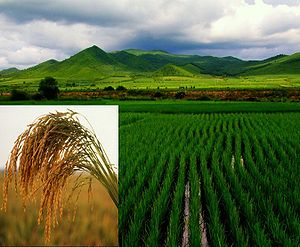
Rice (Oryza sativa) was the second plant genome (after Arabidopsis) to be published, making it the first monocot genome, the first grass genome, the first food crop genome, and the first grain genome (and probably a whole lot of other firsts as well). The original published genome (published in 2002) was from the subspecies Oryza sativa japonica, however the genome of the other primary subspecies Oryza sativa indica has also been sequenced.
The current version of the rice genome in CoGe is v6.1 from MSU which contains ~370 megabases of sequence and 40,577 non-transposon related genes spread across 12 chromosomes.
Rice Resources:
- The MSU Rice Gene Annotation Project the source of the gene annotations used by CoGe
- RAP-DB: The Rice Annotation Project Database. A different set of annotations for the rice genome
The genome paper:
Goff, S. et al. (2002). A Draft Sequence of the Rice Genome (Oryza sativa L. ssp. japonica) Science, 296 (5565), 92-100 DOI: 10.1126/science.1068275
Brachypodium

The brachy genome (Brachypodium distachyon) was published in early 2010. Brachypodium is a small temperate grass native found around the Mediterranean, and east into India. Its choice as a model organism was based on small physical size, quick generation time, and small genome (a lot of the same reasons as Arabidopsis) as well as its membership in the Pooideae, a group of grass species that also includes important crop species: wheat, barley, rye, and oats all species whose genomes have not yet been sequenced (although the last common ancestor of brachy and these important crop species is estimated to have lived >30 million years ago). Brachy's genome is currently the only published genome of a non-domesticated grass and the only temperate (as opposed to tropical) grass.
The published version of the brachy genome includes 272 megabases of sequence and 25,532 protein coding genes spread across five chromosomes. It was sequenced to a coverage of 9.4× using Sanger sequencing.
Brachy Resources:
- Brachypodium.org is probably the first place to check.
- Brachy's page at JGI
The genome paper:
Vogel, J., Garvin, D., Mockler, T., Schmutz, J., Rokhsar, D., Bevan, M., Barry, K., Lucas, S., Harmon-Smith, M., Lail, K., Tice, H., Schmutz (Leader), J., Grimwood, J., McKenzie, N., Bevan, M., Huo, N., Gu, Y., Lazo, G., Anderson, O., Vogel (Leader), J., You, F., Luo, M., Dvorak, J., Wright, J., Febrer, M., Bevan, M., Idziak, D., Hasterok, R., Garvin, D., Lindquist, E., Wang, M., Fox, S., Priest, H., Filichkin, S., Givan, S., Bryant, D., Chang, J., Mockler (Leader), T., Wu, H., Wu, W., Hsia, A., Schnable, P., Kalyanaraman, A., Barbazuk, B., Michael, T., Hazen, S., Bragg, J., Laudencia-Chingcuanco, D., Vogel, J., Garvin, D., Weng, Y., McKenzie, N., Bevan, M., Haberer, G., Spannagl, M., Mayer (Leader), K., Rattei, T., Mitros, T., Rokhsar, D., Lee, S., Rose, J., Mueller, L., York, T., Wicker (Leader), T., Buchmann, J., Tanskanen, J., Schulman (Leader), A., Gundlach, H., Wright, J., Bevan, M., Costa de Oliveira, A., da C. Maia, L., Belknap, W., Gu, Y., Jiang, N., Lai, J., Zhu, L., Ma, J., Sun, C., Pritham, E., Salse (Leader), J., Murat, F., Abrouk, M., Haberer, G., Spannagl, M., Mayer, K., Bruggmann, R., Messing, J., You, F., Luo, M., Dvorak, J., Fahlgren, N., Fox, S., Sullivan, C., Mockler, T., Carrington, J., Chapman, E., May, G., Zhai, J., Ganssmann, M., Guna Ranjan Gurazada, S., German, M., Meyers, B., Green (Leader), P., Bragg, J., Tyler, L., Wu, J., Gu, Y., Lazo, G., Laudencia-Chingcuanco, D., Thomson, J., Vogel (Leader), J., Hazen, S., Chen, S., Scheller, H., Harholt, J., Ulvskov, P., Fox, S., Filichkin, S., Fahlgren, N., Kimbrel, J., Chang, J., Sullivan, C., Chapman, E., Carrington, J., Mockler, T., Bartley, L., Cao, P., Jung, K., Sharma, M., Vega-Sanchez, M., Ronald, P., Dardick, C., De Bodt, S., Verelst, W., Inzé, D., Heese, M., Schnittger, A., Yang, X., Kalluri, U., Tuskan, G., Hua, Z., Vierstra, R., Garvin, D., Cui, Y., Ouyang, S., Sun, Q., Liu, Z., Yilmaz, A., Grotewold, E., Sibout, R., Hematy, K., Mouille, G., Höfte, H., Michael, T., Pelloux, J., O’Connor, D., Schnable, J., Rowe, S., Harmon, F., Cass, C., Sedbrook, J., Byrne, M., Walsh, S., Higgins, J., Bevan, M., Li, P., Brutnell, T., Unver, T., Budak, H., Belcram, H., Charles, M., Chalhoub, B., & Baxter, I. (2010). Genome sequencing and analysis of the model grass Brachypodium distachyon Nature, 463 (7282), 763-768 DOI: 10.1038/nature08747
Maize/Corn
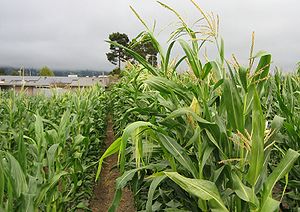
The genome of the species known to most Americans as corn (Zea mays) and to biologists and Europeans as maize was published in the second half of 2009. Maize genetics has a history going back more than a century to the early work R. A. Emerson, widely considered the founder of modern maize genetics. Maize is an important crop species, and the most prominent crop species to engage in C4 photosynthesis (as opposed to the more standard C3 photosynthesis). The role of maize as an important model system as well as a vital crop might have placed it earlier in the order of plants to have their genomes sequenced if not for the complexity of the genome itself.
The ancestor of maize went through a whole genome duplication between 5 and 12 million years ago. In additio, the recent history of maize has included not one but two blooms of transposon activity. The result is a genome that weighs in at ~2.5 gigabases of mostly repetitive sequence, making both sequencing and assembly major challenges.
But the maize genome sequence is now published.
The v1 sequence contains 2.3 gigabases of sequence data. Rather than shotgun sequencing of the entire genome as is now common with smaller less repetitive genomes, maize was sequenced using a BAC[5] by BAC approach. The BACs were lined up to cover the ten chromosomes of maize, and then the sequence contained in each BAC was shotgun sequenced and assembled into contigs. What this means in practice is that a given sequence in the maize genome is usually within 300 kilobases of its correct location, but within that range may be out of order or inverted. If a gene seems to be absent from its syntenic location (or only a portion of the gene is found) it is important to search up to 500 kilobases in either direction around its expected location to make sure the apparent deletion isn't the result of incorrect ordering of the contigs.
The next version of the maize sequence (v2) scheduled to be released on April 1st, 2010 should substantially reduce this issue, as over 80% of the contigs in the v2 sequence will have data on their order and orientation, up from ~30% in the v1 release.
A word on gene models:
The maize genome was published with two sets of genome annotations, the working gene set and the filtered gene set. These two sets are based on different compromises between catching all the real genes in maize and excluding false genes.
- The filtered gene set (>32,000 genes) are high confidence genes. If it's in the filtered gene set, it's almost certainly a gene, but there is no promise that EVERY real gene is in the filtered gene get
- The working gene set (~100,000 genes) includes all the genes in the filtered gene set, but also many other gene models that have less supporting gene evidence. Almost every real gene is likely included in the working gene set, but so are many things that aren't genes, particularly gene fragments remaining from the maize whole genome duplication, and pieces of genes captured by transposons.
The maize genome is divided among 10 chromosomes.
Maize Resources:
Maize Related CoGepedia Pages:
- Classical Maize Genes: ~460 maize genes that we have manually mapped to gene models in the published genome sequence, plus data on syntenic orthologs in rice, sorghum, and brachy, as well as the homeologous region of maize.
- MaizeGDB and CoGe: Explaining how to jump between our site and MaizeGDB
- Maize Sorghum Syntenic dotplot: How to compare the maize and sorghum genomes.
The genome paper:
Schnable, P., Ware, D., Fulton, R., Stein, J., Wei, F., Pasternak, S., Liang, C., Zhang, J., Fulton, L., Graves, T., Minx, P., Reily, A., Courtney, L., Kruchowski, S., Tomlinson, C., Strong, C., Delehaunty, K., Fronick, C., Courtney, B., Rock, S., Belter, E., Du, F., Kim, K., Abbott, R., Cotton, M., Levy, A., Marchetto, P., Ochoa, K., Jackson, S., Gillam, B., Chen, W., Yan, L., Higginbotham, J., Cardenas, M., Waligorski, J., Applebaum, E., Phelps, L., Falcone, J., Kanchi, K., Thane, T., Scimone, A., Thane, N., Henke, J., Wang, T., Ruppert, J., Shah, N., Rotter, K., Hodges, J., Ingenthron, E., Cordes, M., Kohlberg, S., Sgro, J., Delgado, B., Mead, K., Chinwalla, A., Leonard, S., Crouse, K., Collura, K., Kudrna, D., Currie, J., He, R., Angelova, A., Rajasekar, S., Mueller, T., Lomeli, R., Scara, G., Ko, A., Delaney, K., Wissotski, M., Lopez, G., Campos, D., Braidotti, M., Ashley, E., Golser, W., Kim, H., Lee, S., Lin, J., Dujmic, Z., Kim, W., Talag, J., Zuccolo, A., Fan, C., Sebastian, A., Kramer, M., Spiegel, L., Nascimento, L., Zutavern, T., Miller, B., Ambroise, C., Muller, S., Spooner, W., Narechania, A., Ren, L., Wei, S., Kumari, S., Faga, B., Levy, M., McMahan, L., Van Buren, P., Vaughn, M., Ying, K., Yeh, C., Emrich, S., Jia, Y., Kalyanaraman, A., Hsia, A., Barbazuk, W., Baucom, R., Brutnell, T., Carpita, N., Chaparro, C., Chia, J., Deragon, J., Estill, J., Fu, Y., Jeddeloh, J., Han, Y., Lee, H., Li, P., Lisch, D., Liu, S., Liu, Z., Nagel, D., McCann, M., SanMiguel, P., Myers, A., Nettleton, D., Nguyen, J., Penning, B., Ponnala, L., Schneider, K., Schwartz, D., Sharma, A., Soderlund, C., Springer, N., Sun, Q., Wang, H., Waterman, M., Westerman, R., Wolfgruber, T., Yang, L., Yu, Y., Zhang, L., Zhou, S., Zhu, Q., Bennetzen, J., Dawe, R., Jiang, J., Jiang, N., Presting, G., Wessler, S., Aluru, S., Martienssen, R., Clifton, S., McCombie, W., Wing, R., & Wilson, R. (2009). The B73 Maize Genome: Complexity, Diversity, and Dynamics Science, 326(5956), 1112-1115 DOI: 10.1126/science.1178534
Sorghum
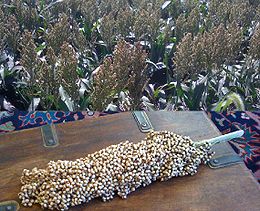
Sorghum (Sorghum bicolor) is an important grain species. A close relative of maize, sorghum is generally considered to be an even more stress tolerant crop. Like maize it carries out C4 photosynthesis. It does not share the recent whole genome duplication seen in maize, which makes it an excellent outgroup from studies of that event in maize as the common ancestor of maize and sorghum is estimated to have lived only 12 million years ago.
The sorghum genome was published in 2009. The current version in CoGe (v1.4) contains ~700 megabases of sequence and 34,496 protein coding genes spread over ten chromosomes. The sorghum genome sequence is available from phytozome.
The genome paper: Paterson, A., Bowers, J., Bruggmann, R., Dubchak, I., Grimwood, J., Gundlach, H., Haberer, G., Hellsten, U., Mitros, T., Poliakov, A., Schmutz, J., Spannagl, M., Tang, H., Wang, X., Wicker, T., Bharti, A., Chapman, J., Feltus, F., Gowik, U., Grigoriev, I., Lyons, E., Maher, C., Martis, M., Narechania, A., Otillar, R., Penning, B., Salamov, A., Wang, Y., Zhang, L., Carpita, N., Freeling, M., Gingle, A., Hash, C., Keller, B., Klein, P., Kresovich, S., McCann, M., Ming, R., Peterson, D., Mehboob-ur-Rahman, ., Ware, D., Westhoff, P., Mayer, K., Messing, J., & Rokhsar, D. (2009). The Sorghum bicolor genome and the diversification of grasses Nature, 457 (7229), 551-556 DOI: 10.1038/nature07723
Foxtail Millet (unreleased)
Foxtail Millet (Setaria italica) is a C4 grass that is much more distantly related to maize and sorghum. the genome has been sequenced by JGI and is currently listed as completed in October of 2009 with a release data of March 1st 2010. As of March 12th 2010, I haven't been able to find the genome sequence. Please write us if you know more!
Non-angiosperms
Planned, In-progress, and Private genome sequencing efforts (a partial list)
- Mars (the candy company) announced they would fund the sequencing the genome of the cacao tree (Theobroma cacao) back in 2008 and that the sequence would be freely available when complete. There were some talks at this year's plant and animal genome meeting, but I've no idea how far along the project is. You can check out CacaoDB but there's currently very little on their site.
- Bayer CropScience announced they have a complete genome sequence for canola (Bassica napus) as well as varieties of Brassica rapa and Brassica oleracea. These aren't being released publicly, but from what I've heard they are open to collaborating with individual researchers who want access to the data.
- Seed plant genomes listed by JGI in approximate order of progress (as best I can tell I've listed those closest to completion at the top):
- Cotton (Gossypium raimondii)
- Columbine(Aquilegia coerulea)
- Boechera stricta Arabidopsis relative
- Rose Gum Tree (Eucalyptus grandis)
- Thellungiella halophila Salt tolerant arabidopsis relative
- Capsella rubella Arabidopsis relative
- Seagrass (Zostera marina) a monocot.
- Brassica rapa Turnips and other vegetables
- Loblolly Pine (Pinus taeda)
- Arabidopsis halleri Arabidopsis species
- Boechera holboellii Arabidopsis relative
- Miscanthus giganteus a biofuel crop not unlike switchgrass
- Panic grass (Panicum hallii) a switchgrass relative
- Beans (Phaseolus vulgaris)
- Duck weed (Spirodela polyrhiza) a monocot
- Arabidopsis arenosa an arabidopsis species
- Boechera divericarpa an arabidopsis relative
- Switchgrass (Panicum virgatum)
- Purple willow (Salix purpure)
Footnotes
- ↑ 1.0 1.1 Groupings of dna sequence that correspond to the individual chromosomes of an organisms
- ↑ 2.0 2.1 Need to define gene models in tomato entry
- ↑ Literally one uping the 1000 genome project that plans to sequence the genomes of 1000 people
- ↑ Estimated to be 6.7 billion people as of early 2010
- ↑ Bacterial artificial chromosome. A way of break down a genome into managable chunks of ~300 kilobases